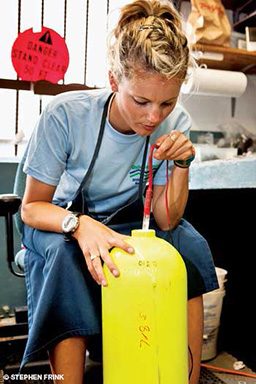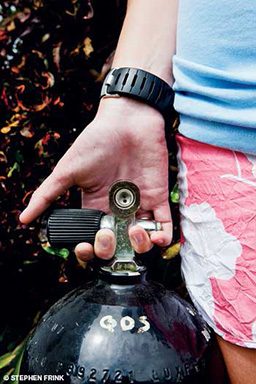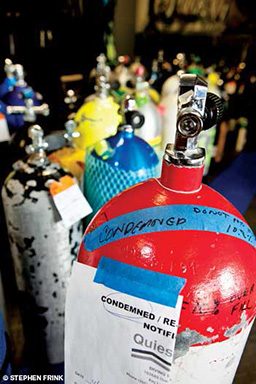Most divers assume their cylinders are safe, but few really understand the relevant standards and maintenance practices. Do you know what protocols are used to guide the inspection of your life-support equipment? Do you know how to safely handle and transport high-pressure cylinders? You should know a lot about the care and proper use of your cylinders because it is the owner (not the fill-station operator, the dive center or the hydrostatic requalifier) who is responsible for a cylinder’s condition.

Standards
Cylinders are authorized for continued service when inspected and tested to applicable standards by a formally trained person. Inspection and testing are crucial because a cylinder can be very dangerous when handled improperly or inadequately maintained. High-pressure cylinders have a tremendous amount of potential energy; an aluminum 80-cubic-foot cylinder, for example, has approximately 1.3 million foot-pounds potential energy. (One foot-pound is the amount of energy applied to 1 pound to move it 1 foot.) Yet divers expose their cylinders to extremely harsh conditions including salt water, high temperatures and rough treatment without a second thought about the potential risks.
Any cylinder containing more than 40 pounds per square inch (psi) is considered high pressure according to the Occupational Safety and Health Administration (OSHA). Most divers are familiar with the hydrostatic requalification (commonly referred to as “hydro”) federal regulations require of solid-wall cylinders every five years. Many believe if a cylinder passes the requalification it is safe, but the truth is that more cylinders fail visual inspection than hydrostatic retesting. Some divers erroneously believe visual inspections are a method for dive centers to make money and there are no formal requirements. In fact, the dive industry established annual visual inspection using a practice backed up by the Compressed Gas Association (CGA).
Know Your Cylinder
How can divers quickly determine whether a cylinder is fit for service? A cursory inspection should be performed each time a cylinder is handled. Compare the cylinder you are about to use to a new one. (It’s OK to imagine a new one if there is not one nearby.) Does it appear undamaged? Does it make any noise, such as a rattle or sounds of air escaping? Cylinders should never make sounds when lifted or transported. If there is a rattling or sloshing sound, there is most likely something wrong.
Corrosion in cylinders usually results from water introduced at the fill station or because there are several drops left in the valve after its last use or rinsing. A fill whip at 3,000 psi will atomize the drops into a vapor that coats the interior of the cylinder. Always open the valve and blow out the valve aperture prior to filling a cylinder (it’s best to do this before you enter the dive center). This is especially important if you use a DIN valve as these may hold as many as 12 to 15 drops of water. Ask the fill station operator to blow out the fill whip prior to attaching it to your cylinder to prevent introducing dirt, dust or any other particulate matter. Keeping a clean, dry dust cap on your cylinder valve at all times except during fills and dives will also go a long way to keeping the cylinder and valve free from contaminants.

Transport
Many divers don’t put much thought into how they lift their cylinders. If you pick it up with the orifice toward your hand, this may open the hand wheel as you lift, blowing high pressure gas against your skin and possibly causing skin penetration and subcutaneous emphysema. Always lift the cylinder with the orifice away from your hand, thus closing the hand wheel while lifting. Occasionally you may see “old salts” stacking cylinders like cordwood, not considering that a valve is chrome-plated brass and easily damaged. Rapid gas escape from a damaged valve may cause a cylinder to move very quickly and cause injury to bystanders.
It’s easy to underestimate the hazard associated with transporting cylinders in motor vehicles, so consider that cylinders in a vehicle move at the same speed as the vehicle. If you have a collision, the vehicle will slow rapidly while the unrestrained (or insufficiently restrained) cylinders may continue to move at your original speed. An aluminum 80-cubic-foot cylinder weighs approximately 34 pounds at rest, but at 60 miles per hour it weighs 4,091 foot-pounds. Straps that can be used to restrain cylinders are inexpensive and available at most hardware stores.
Care and Maintenance

In addition to being responsible for a cylinder’s condition, the owner is also responsible for a cylinder’s use. Diving is a social sport in which we often meet up with friends at dive sites. If others show up while you are in the middle of assembling your dive kit, don’t let their arrival distract you — never leave a cylinder standing unattended. Always lay cylinders down whenever they are out of reach to prevent them from falling or being knocked over. Try, too, to keep spare cylinders from being exposed to extreme temperatures; for example, find some shade for them on summer days.
What constitutes proper care of cylinders? First, rinse them with fresh water at the end of every day of diving. If you use attachments such as pony cylinder brackets, tank boots or twin bands, soak these in fresh water. This promotes dissolution of any salt water trapped behind the attachments. Always dry cylinders before storing them. If you store a cylinder for a prolonged period (more than 90 days per the CGA), reduce the pressure to the lowest you can read on the pressure gauge. Always be sure the person who inspects your cylinder is formally trained by a recognized agency, and use only a reputable requalifier for hydrostatic testing.
High-pressure cylinders are a vital part of our diving ensemble. When cared for and handled according to established standards, they are very safe and will provide many years of service.
© Alert Diver — Q2 Spring 2012